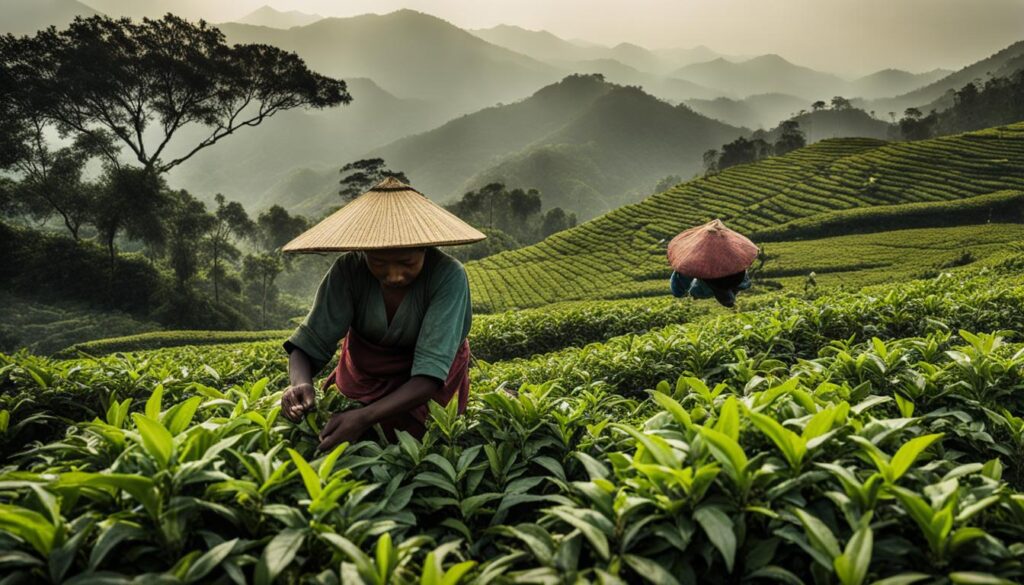The tea industry in the United States has been experiencing significant growth in recent years, with the market size reaching $12.7 billion in 2020. It is projected to reach $16.2 billion by 2026. To enter the tea plantation business successfully, it is important to conduct thorough research on the industry, including studying different types of tea, examining market trends and demand, and exploring tea-growing regions. Additionally, a feasibility study should be conducted to evaluate market demand, competition, and financial requirements. Location, size, and soil conditions are also crucial factors for a successful tea plantation. Analyzing existing players in the tea industry and creating a comprehensive financial and marketing plan are essential for success. Building a brand, establishing a production and sourcing plan, and creating a management and staffing plan are also important steps in tea cultivation.
Key Takeaways:
- Thorough research is necessary for success in the tea industry.
- Conduct a feasibility study to assess market demand and competition.
- Consider location, size, and soil conditions for a successful tea plantation.
- Create a comprehensive financial and marketing plan.
- Build a brand and establish a production and sourcing plan.
Researching the Tea Industry
Thorough research of the tea industry is essential before starting a tea plantation business. By studying different types of tea, analyzing market trends and demand, and exploring tea-growing regions, tea farmers can make informed decisions and develop a solid business plan. Understanding consumer preferences and market demands is crucial for effective marketing and sales strategies.
One important aspect of researching the tea industry is identifying the target market and understanding customer demographics. This involves researching tea consumption habits, popular flavors, and customer preferences. By knowing who their potential customers are, tea farmers can tailor their products and marketing efforts to better meet their needs.
Another key part of tea industry research is analyzing the competition and identifying gaps in the market. By studying existing players in the tea industry, tea farmers can learn from their successes and failures, and find ways to differentiate themselves. Incorporating market trends and innovations can also give tea farmers a competitive edge in the industry.
“Thorough research of the tea industry is the foundation for success in the tea plantation business. By understanding market trends, target customers, and the competitive landscape, tea farmers can make informed decisions and develop effective strategies.”
Table: Tea Consumption Habits by Customer Demographics
| Customer Demographic | Tea Consumption Habits |
|---|---|
| Young professionals | Prefer convenient and ready-to-drink tea options; open to trying new tea flavors |
| Health-conscious individuals | Seek herbal and organic tea options; prioritize natural ingredients and health benefits |
| Tea enthusiasts | Appreciate specialty and premium teas; enjoy exploring different tea varieties and brewing methods |
By conducting thorough research on the tea industry, including market trends, target market, and customer demographics, tea farmers can lay a strong foundation for their tea plantation business. This knowledge will guide their decisions and help them develop effective marketing strategies that resonate with their target customers. Stay tuned for the next section, where we’ll delve into conducting a feasibility study for a tea plantation business.
Conducting a Feasibility Study
Before embarking on a tea plantation business, it is crucial to conduct a comprehensive feasibility study. This study allows tea farmers to evaluate the market demand, assess the level of competition, and determine the financial viability of their venture. By conducting a feasibility study, tea farmers can make informed decisions and increase the chances of success.
Market Demand: Understanding the market demand for tea is essential for a successful business. The feasibility study analyzes the current and projected demand for various types of tea, taking into account factors such as consumer preferences, trends, and demographics. This information helps tea farmers tailor their production and marketing strategies to meet the needs of their target market.
Competition: Assessing the level of competition in the tea industry is another crucial aspect of the feasibility study. It involves researching existing tea plantations, distributors, and retail outlets to identify potential competitors. By understanding their strengths, weaknesses, and market positioning, tea farmers can develop strategies to differentiate their products and stand out in the market.
Financial Viability: The financial viability of a tea plantation business is determined through a detailed analysis of the financial aspects. This includes evaluating the initial investment required, operational costs, pricing strategies, and revenue projections. By conducting a thorough assessment, tea farmers can ascertain whether their business idea is financially sustainable and make necessary adjustments to ensure profitability.
| Feasibility Study Components | Description |
|---|---|
| Market Demand | Assessing the current and projected market demand for tea, considering consumer preferences, trends, and demographics. |
| Competition | Evaluating the level of competition in the tea industry, including existing tea plantations, distributors, and retail outlets. |
| Financial Viability | Analyzing the financial aspects of the tea plantation business, including the initial investment, operational costs, pricing strategies, and revenue projections. |
In conclusion, conducting a feasibility study is an essential step in starting a tea plantation business. It provides valuable insights into market demand, competition, and financial viability. By thoroughly analyzing these aspects, tea farmers can make informed decisions and increase their chances of success in the competitive tea industry.
Environmental Sustainability in Tea Cultivation
As responsible tea farmers, we strive to prioritize environmental sustainability in our cultivation practices. By implementing strategies such as biodiversity preservation, soil conservation, resource and input management, and climate change adaptation, we aim to minimize the negative impact on our planet while producing high-quality tea that meets the demands of our customers.
The Importance of Biodiversity Preservation
In our tea plantations, we recognize the significance of preserving biodiversity. By maintaining a balanced ecosystem, we can enhance the natural resilience of our crops and protect the habitats of various plant and animal species. Through the careful management of our plantations and the preservation of natural areas within our farms, we contribute to the overall health of the environment.
Soil Conservation for Sustainable Farming
Soil conservation is another essential aspect of our sustainable tea cultivation practices. We employ techniques such as contour plowing, terracing, and cover cropping to prevent soil erosion and maintain the soil’s nutrient balance. Additionally, we prioritize the recycling of organic matter and crop waste, which helps improve soil fertility and reduces the need for synthetic fertilizers.
Resource and Input Management
In our commitment to environmental sustainability, we focus on efficient resource and input management. We strive to use sustainable levels of pesticides, promoting integrated pest management practices to minimize the impact on beneficial insects and the surrounding ecosystem. Furthermore, we prioritize energy conservation and explore renewable energy sources to reduce our carbon footprint.
Adapting to Climate Change
With the increasing challenges posed by climate change, we understand the importance of adapting our tea cultivation practices. We consider land conversion strategies, such as planting shade trees, to mitigate the effects of rising temperatures. Additionally, we monitor and manage our carbon stock to contribute to carbon sequestration efforts and reduce greenhouse gas emissions.
Overall, our environmental sustainability efforts in tea cultivation encompass various practices that prioritize the well-being of our planet. By preserving biodiversity, conserving soil, managing resources and inputs efficiently, and adapting to climate change, we aim to foster a sustainable future for both our tea industry and the environment as a whole.

| Sustainability Practices | Benefits |
|---|---|
| Biodiversity Preservation | Enhanced ecosystem resilience and protection of habitats |
| Soil Conservation | Prevention of soil erosion, improved fertility, and reduced dependence on synthetic fertilizers |
| Resource and Input Management | Minimization of pesticide use, energy conservation, and exploration of renewable energy sources |
| Adapting to Climate Change | Mitigation of rising temperatures, carbon sequestration, and reduced greenhouse gas emissions |
Social and Economic Sustainability in Tea Cultivation
In our pursuit of best practices in tea cultivation, we recognize the importance of social and economic sustainability. By prioritizing favorable labor conditions, local employment, and generational renewal, we can contribute to the long-term viability of the tea industry.
Ensuring favorable labor conditions is essential for the well-being of tea farmers and workers. We are committed to complying with organic agricultural standards and actively negotiating labor conditions with local governments and unions. By fostering a safe and supportive work environment, we aim to enhance the quality of life for those involved in tea cultivation.
Furthermore, promoting local employment is crucial for the economic growth of tea-growing regions. During the tea harvesting seasons, we prioritize the hiring of local residents, providing them with valuable income opportunities. By supporting local communities, we contribute to the overall well-being and development of the regions where we operate.
Generational renewal is another key aspect of social and economic sustainability in tea cultivation. To ensure the future of the tea industry, we actively engage with schools and young individuals, promoting interest in primary industries and offering support for aspiring tea farmers. By nurturing the next generation of tea cultivators, we secure the continued growth and success of the tea industry.

Fostering Economic Sustainability
Economic sustainability is vital for the tea cultivation industry. To achieve this, we focus on preserving the soil, maintaining high harvest yields, and ensuring the economic viability of tea farming. By implementing sustainable practices, we can protect the environment and maximize the economic benefits of tea cultivation.
Table: Economic Sustainability in Tea Cultivation
| Key Factors | Impact |
|---|---|
| Soil Preservation | Promotes long-term productivity and minimizes the need for costly soil restoration. |
| High Harvest Yields | Maximizes revenue potential and ensures the economic viability of tea farming. |
| Economic Viability | Provides a sustainable income source for tea farmers and supports the growth of the industry. |
By prioritizing social and economic sustainability in tea cultivation, we contribute to the overall well-being of tea farmers, workers, and local communities. Through favorable labor conditions, local employment initiatives, and generational renewal programs, we ensure the longevity and prosperity of the tea industry.
Conclusion
After exploring the intricacies of tea cultivation, we can confidently say that adopting best practices is essential for the sustainability of the tea industry. It all starts with thorough research of the tea industry, understanding different types of tea, market trends, and demand. This knowledge empowers tea farmers to make informed decisions and develop a solid business plan.
Additionally, conducting a feasibility study is crucial to assess market demand, competition, and the overall financial viability of a tea plantation. This study provides valuable insights to mitigate risks and ensure the success of the business. It helps determine the initial investment, land acquisition, equipment, labor, and marketing expenses.
But sustainability goes beyond financial aspects. Environmental sustainability plays a vital role in tea cultivation. By implementing practices like soil conservation, biodiversity preservation, and resource management, tea farmers contribute to the long-term health of the environment. Similarly, social and economic sustainability involve fostering favorable labor conditions, supporting local employment, and promoting generational renewal.
To thrive in the tea industry, it is crucial to prioritize best practices that encompass market demand, competition analysis, soil conservation, biodiversity preservation, labor conditions, and economic viability. By doing so, we ensure the long-term success of our tea plantation businesses and contribute to the overall growth and sustainability of the tea industry.
FAQ
What are the best practices in tea cultivation?
The best practices in tea cultivation include thorough industry research, conducting a feasibility study, implementing environmentally and socially sustainable practices, and focusing on factors such as market demand, soil conservation, labor conditions, and economic sustainability.
What should I research in the tea industry?
When researching the tea industry, you should study different types of tea, analyze market trends and demand, explore tea-growing regions, and understand consumer preferences and customer demographics. This research will help you make informed decisions and develop a solid business plan.
How do I conduct a feasibility study for a tea plantation business?
Conducting a feasibility study for a tea plantation business involves assessing market demand, evaluating competition, and determining the financial viability of the venture. You need to consider factors such as the initial investment, land acquisition, equipment, labor, and marketing expenses. The feasibility study provides valuable insights to ensure the success of your business.
What are the key aspects of environmental sustainability in tea cultivation?
Environmental sustainability in tea cultivation involves practices such as soil conservation, biodiversity preservation, resource and input management, and adaptation to climate change. Tea farmers focus on maintaining nutrient balance, preventing erosion, using sustainable levels of pesticides, and practicing integrated pest management. They also consider land conversion and carbon stock to adapt to climate change.
How can social and economic sustainability be achieved in tea cultivation?
Social and economic sustainability in tea cultivation are achieved by ensuring favorable labor conditions, fostering local employment, and promoting generational renewal. Tea farmers focus on enhancing labor conditions, complying with organic agricultural standards, and supporting local employment opportunities. They also contribute to generational renewal by developing interest in tea farming among schoolchildren and supporting young tea farmers.
What are the key points to remember about tea cultivation best practices?
Adopting best practices in tea cultivation requires thorough research of the tea industry, conducting a feasibility study, and implementing environmentally and socially sustainable practices. By focusing on market demand, competition, soil conservation, biodiversity preservation, labor conditions, and economic sustainability, tea farmers can ensure the long-term viability of their tea plantation businesses.
Source Links
- https://finmodelslab.com/blogs/write-business-plan/how-to-write-business-plan-for-tea-plantation
- https://oxfordre.com/environmentalscience/view/10.1093/acrefore/9780199389414.001.0001/acrefore-9780199389414-e-373?mediaType=Article
- https://teavoyages.com/2021/03/31/sustainability_practices_beyond_organic_fairtrade_labels/





